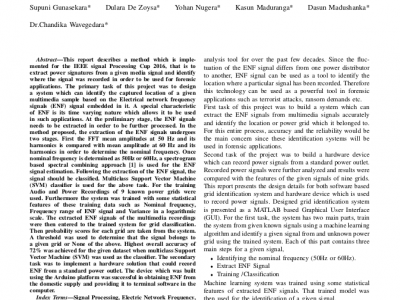Documents
Report
IEEE Signal Processing Cup 2016 - Team Ravan

- Citation Author(s):
- Submitted by:
- Dulanga Weerakoon
- Last updated:
- 21 August 2017 - 5:01am
- Document Type:
- Report
- Document Year:
- 2015
- Event:
- Categories:
- Log in to post comments
This report describes a method which is implemented for the IEEE signal Processing Cup 2016, that is to extract power signatures from a given media signal and identify where the signal was recorded in order to be used for forensic applications.
The primary task of this project was to design a system which can identify the captured location of a given multimedia sample based on the Electrical network frequency signals (ENF) signal embedded in it.
A special characteristic of ENF is its time varying nature which allows it to be used in such applications. At the preliminary stage, the ENF signals needs to be extracted in order to be further processed. In the method proposed, the extraction of the ENF signals undergoes two stages. First the FFT mean amplitudes at 50 Hz and its harmonics is compared with mean amplitude at 60 Hz and its harmonics in order to determine the nominal frequency. Once nominal frequency is determined as 50Hz or 60Hz, a spectrogram based spectral combining approach [1] is used for the ENF signal estimation.
Following the extraction of the ENF signal, the signal should be classified. Multiclass Support Vector Machine (SVM) classifier is used for the above task. For the training Audio and Power Recordings of 9 known power grids were used. Furthermore the system was trained with some statistical features of these training data such as Nominal frequency, Frequency range of ENF signal and Variance in a logarithmic scale. The extracted ENF signals of the multimedia recordings were then entered to the trained system for grid classification. Then probability scores for each grid are taken from the system. A threshold was used to determine that the signal belongs to a given grid or ‘None of the above’. Highest overall accuracy of 72% was achieved for the given dataset when multiclass Support Vector Machine(SVM) was used as the classifier.
The secondary task was to implement a hardware solution that could record ENF from a standard power outlet. The device which was built using the Arduino platform was successful in obtaining ENF from the domestic supply and providing it to terminal software in the computer.

